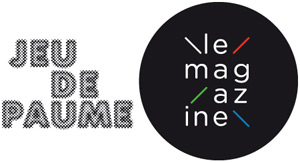Aernout Mik, Communitas
Société Réaliste: Empire, State, Building
Alex Cecchetti and Mark Geffriaud: The Police Return to the Magic Shop
Until 8 May 2011
Jeu de Paume
1, Place de la Concorde
75008 Paris
www.jeudepaume.org
lemagazine.jeudepaume.org
This retrospective exhibition brings together a selection of Aernout Mik’s works from the last ten years, with an emphasis on the most recent ones, including his new video installation, Shifting Sitting, produced specially for the occasion. Eight installations in all are presented in a setting designed by the artist, who treats these architectural constructions as an integral part of the work.
The exhibition bears the title of a video from 2010: “Communitas” is used in sociology and philosophy to evoke transitional phases that escape everyday social order, or to define unstructured communities where individuals are equal, such as medieval pilgrimages and certain African rites. Mik’s installations create such experimental or “anti-structured” assemblies that escape any kind of normality and in which each person’s role is never sure or stable.
The exhibition aims to create new connections between the different ways the artist is handling space, whether in his architectural installations or in his projections. It also presents the connections between his found footage-based works and documentaries (Raw Footage, 2006) and works that are wholly staged (Schoolyard, 2009, Osmosis and Excess, 2005, Park, 2002 and Middlemen, 2001). These pieces reflect different forms of violence, aggression and tension, and show the diversity of behaviors: gatherings, clashes, rituals and collective obsessions.
Shot in Italy, Aernout Mik’s latest installation, Shifting Sitting (2011), continues his long-standing exploration of the different forms of democracy in Europe. The scene is set in a courtroom. We are watching a trial inspired by the legal imbroglios in which Silvio Berlusconi has been involved ever since first coming to power in the 1990s. But while the allusion to Italian political and financial scandals is clear, the film does not refer to any specific trial. Rather, it illustrates the shifts that occur between political structures (as democratic formations and agents of power) and legal structures, for these two levels are constantly mixing, passing from spontaneous modes of popular organisation to fixed, ritualised forms.
Curators: Leontine Coelewij, Sabine Maria Schmidt and Marta Gili
Exhibition produced by Jeu de Paume (Paris), Museum Folkwang (Essen) and the Stedelijk Museum (Amsterdam)
Société Réaliste: Empire, State, Building
Société Réaliste is a Parisian cooperative created by Ferenc Gróf and Jean-Baptiste Naudy in June 2004. It works with political design, experimental economy, territorial ergonomy and social engineering consulting.
“Empire, State, Building” obviously evokes the famous New York skyscraper, this “building/temple/monument/work of art” that, ever since its completion in 1931, has been both a myth and emblem of the United States, as well as a source of artistic inspiration (from the Merian C. Cooper/Ernest B. Schoedsack film King Kong in 1933 to Empire, Andy Warhol’s silent movie, made in 1964). Secondly, the exhibition explores the possibilities of punctuation, insofar as it can be used to order or disorder discourse. Finally, the name of the myth, when altered by the disorder of signs, becomes something different, a grid decreasing the scales of perception and power, from empire to building, via the state.
The exhibition is articulated around two pivotal pieces: The Fountainhead (2010) and Cult of She-manity (2011). What Ayn Rand’s objectivism (The Fountainhead) and Auguste Comte’s positivism (Cult of She-manity) have in common is that both justify the dominant order and argue for the necessity of its accomplishment as a global project in the name of its own naturalised, sanctified reason. The style is cold and pragmatic in Rand, elegiac and morbid in Comte.
It is in this speculative space that Société Réaliste has decided to install a number of its critical apparatus, and apply them to the certain forms through which variation power is produced and reproduced: its sign systems (from typography to cartography), its production of values (from numismatics to the religion of profit), its models of construction of space (from church to skyscraper, from utopian city-state to the frontiers of the empire), its methods for the construction of time (from rewriting history to formulating projects in the remote future).
Curators: Société Réaliste and Marta Gili.
This exhibition is produced by Jeu de Paume, Paris and the Ludwig Múzeum – Museum of Contemporary Art, Budapest.
Alex Cecchetti & Mark Geffriaud: THE POLICE RETURN TO THE MAGIC SHOP
“Alex Cecchetti is an obsessive interrogator of the ways world comes to us. He cannot stop wondering why things emerge, why they strike us with a power of lighting and leave us blind in consequence, and why some of the images they make remain after we die. Many of his inspirations are coming from literature and philosophy.
It is in this library of Babel where his dialogue with Mark Geffriaud usually takes place. “Why sculptures need to breathe?” Alex could ask, and Mark, playing along the lines of geometry, music and history of chance, would approach the story. He often searches for overlaps and lapses, time-warps and grey-holes of history. Making art for him is similar to production of tools of thinking or perceiving space. Yet when I’ve proposed Mark Geffriaud and Alex Cecchetti to collaborate to Satellite presentation, I didn’t expect that the two would decide to embark on adventure to bring a flame of fire from Yanarta Mountain to Jeu de Paume and animate a series of sculptures with it.»
by Raimundas Malašauskas, Curator of the Satellite program.
The Fondation nationale des arts graphiques et plastiques (FNAGP) contributes to the production of the works of the Satellite program.
Jeu de Paume receives a subsidy from the Ministry of Culture and Communication.
It gratefully acknowledges support from Neuflize Vie, its global partner.
*Image above:
Courtesy carlier | gebauer.
Photographer : Florian Braun.



